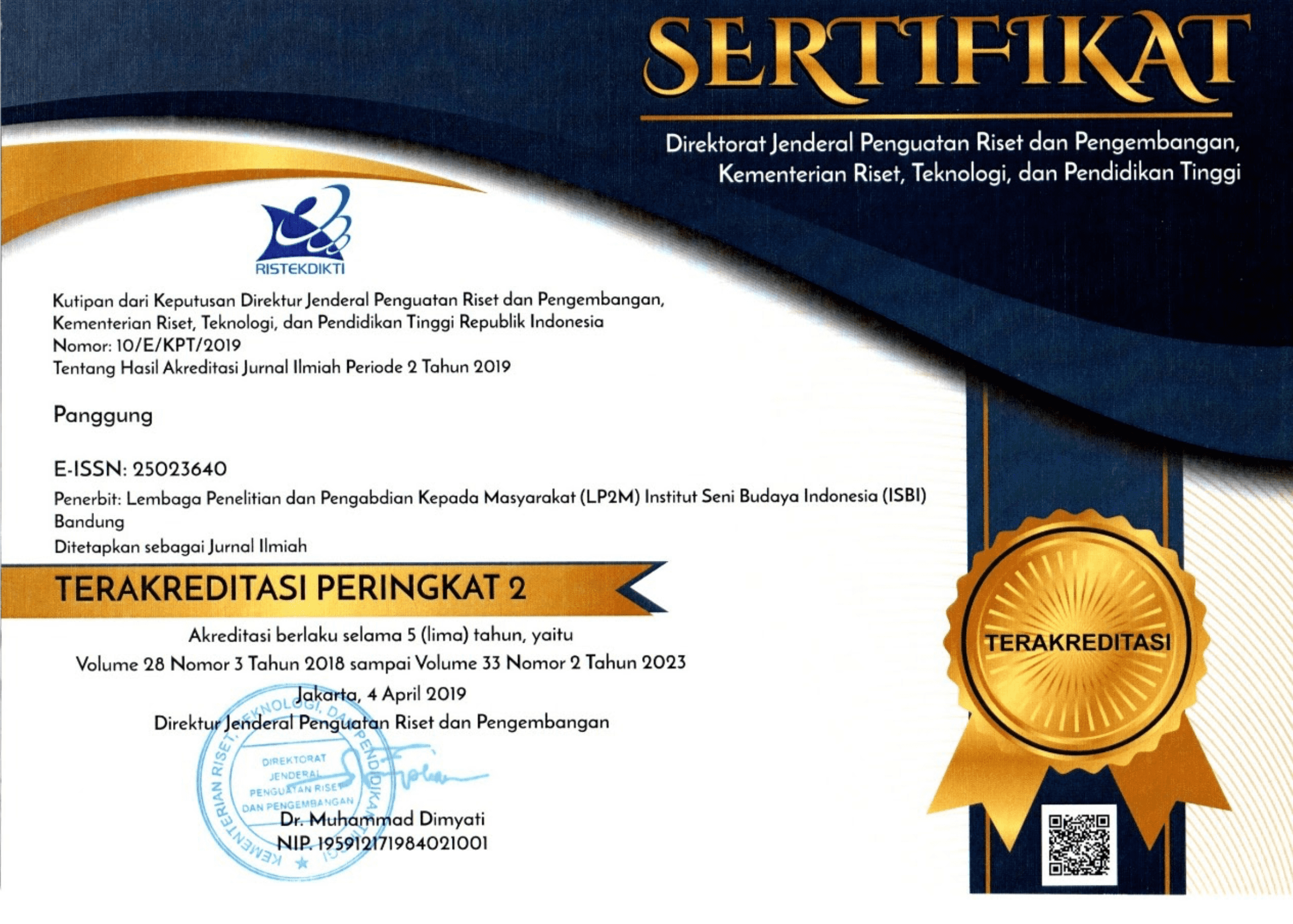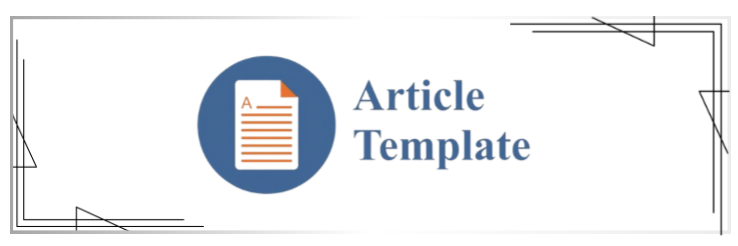Zero-Waste Kebaya Design: Integrating the ‘FRANGIPANI’ Method to Enhance Sustainability and Utilize Leftover Lace
DOI:
https://doi.org/10.26742/panggung.v34i3.3211Keywords:
FRANGIPANI, Kebaya, Lace, Zero Waste PatternAbstract
ABSTRACT
The kebaya, a traditional Indonesian garment, has evolved to incorporate lace fabric in its design. However, traditional cutting and sewing methods may result in fabric waste, contributing to environmental degradation. Regarding this, the study seeks to develop a zero-waste model for kebaya that utilizes leftover lace, preserving its cultural significance while reducing environmental impact. Thus, the research proposes the FRANGIPANI method, a structured approach consisting of ten systematic stages of the design process that can minimize textile waste and promote sustainability in Kebaya production. This method aims to enhance organization and implementation in the production of kebaya while respecting Indonesia’s rich cultural heritage. The primary goal of this research is to identify a more efficient pre-production system that minimizes textile waste. By focusing on sustainable practices, the research explores the potential for redesigning kebaya into a zero-waste model that utilizes leftover lace, thereby preserving its artistic value while promoting environmental sustainability. Keywords: FRANGIPANI, Kebaya, Lace, Waste, Zero Waste Patter
References
Arumsari, A. (2014). Community Empowerment Through Lace’s Waste Development. Arts and Design Studies IISTE, 26, 77–86. www.iiste.org
Arumsari, A. (2020). PENERAPAN DESIGN ETHICS PADA INDUSTRI FESYEN KELAS MENENGAH DI BALI.
Agista, T. P. C., & Handajani, S. (2019, August). Social Movement and Kebaya Design Trends in the Borderless World. In 1st Annual Internatioal Conference on Social Sciences and Humanities (AICOSH 2019) (pp. 95-99). Atlantis Press.
Big Indonesian Dictionary (KBBI). (2016). Badan Pengembangan Dan Pembinaan Bahasa, Kementerian Pendidikan, Kebudayaan, Riset, Dan Teknologi Republik Indonesia.
Decision President Number 19 Year 2023 about National Kebaya Day, Pub. L. No. Nomor 19 Tahun 2023, Keputusan Presiden (KEPPRES) SK No 180090 A (2023).
Denissa, L. (2019). Fesyen Akademik sebagai Alternatif Kebaruan dalam Budaya Populer. Panggung, 29(2).
Diantari, N. K. Y., Arimbawa, I. M. G., & Sudharsana, T. I. R. C. (2018). Representasi Gangsing Pada Busana Wanita Retro Playful. PRABANGKARA Jurnal Seni Rupa Dan Desain, 22, 90–92.
Chan, C. (2020). Textilepedia: The Complete Fabric Guide. Hong Kong: Fashionary.
Fitrah, D. H., & Nursari, F. (2017). PERANCANGAN BUSANA ZERO WASTE DENGAN TEKNIK DRAPING PATTERN MAKING PADA POLA KIMONO. ATRAT, 5, 276–285.
Garlufi, R., & Nursari, F. (2018). POTENSI PENERAPAN TEKNIK ZERO WASTE PATTERN CUTTING PADA DESAIN KEBAYA. ATRAT, 6, 227–234.
Gwilt, A. (2020). A Practical Guide to Sustainable Fashion-second editon: Vol. PB 978-1-3500-6704-2 (Second edition 2020). BLOOMSBURY VISUAL ARTS.
Hardisurya, I., Pambudy, N. M., & Jusuf, H. (2019). Kamus Mode Indonesia (Vols. 978-602-412-677–3). PT Kompas Media Nusantara.
Kartika, D. S. (2007). ESTETIKA (Pertama, Vols. 979-3784-19–9). Rekayasa Sains Bandung.
Kurniadi, C. A. P., & Githapradana, D. M. W. (2023). Utilization of waste fabric for ready-to-wear deluxe unisex clothing design with fabric manipulation technique on Kamisado brand. In Sustainable Development in Creative Industries: Embracing Digital Culture for Humanities (pp. 415-419). Routledge.
Maulana, D. (2021). Kisah Kebaya (Vols. 978-602-06-3610–8). PT Gramedia Pustaka Utama.
Mudarahayu, M. T., Sedana, I. N., Remawa, A. A. G. R., & Sariada, I. K. (2021). Estetika Bentuk Busana Pada Lukisan Wayang Kamasan. Jurnal Panggung, 31(2), 93-104.
Mulyadi, N. T., Nursari, F., & Viniani, P. (2022). Pengaplikasian Konsep Zero Waste Fashion Design Dengan Teknik Engineered Print Pada Busana Ready To Wear Wanita. MODA, 4.
Nagata, T., & Sunarya, Y. Y. (2023). Perkembangan kebaya kontemporer sebagai transformasi budaya. Jurnal Seni dan Reka Rancang: Jurnal Ilmiah Magister Desain, 5(2), 239-254.
Niinimäki, K., G. Peters, H. Dahlbo, P. Perry, T. Rissanen, and A. Gwilt (2020), “The Environmental Price of Fast Fashion,”Nature Reviews Earth & Environment 1: 189–200.
Rahyo. (2023, November 22). Karakteristik Kain Lace.
Rice, S. (2023, March 1). The 3Rs explained (Reduce, Reuse, Recycle). Travelife Accommodation Sustainability.
Rissanen, T., McQuillan, H. (2023). Zero Waste Fashion Design. United Kingdom: Bloomsbury Publishing.
Rosilawati, R., Suparli, L., & Suherti, O. (2023). Relevansi Ide, Konsep dan Bentuk dalam Proses Kreatif Karya Tari ‘Gandrung Liwung’Inspirasi Merak. Jurnal Ilmiah Seni & Budaya Panggung, 33.
Suharno, Fitra, A., & Ganefiani, S. (2021). Semiotika Busana: Model Konstruksi Tanda dalam Penciptaan Busana. Panggung, 31.
Sukmawati, N. K. A., Sudharsana, T. I. R. C., & Sari, D. A. P. L. (2023). Samudra Amerta Analogi Tradisi Muang Jong sebagai Inspirasi Penciptaan Karya Busana dengan Style Feminine Romantic. BHUMIDEVI: Journal of Fashion Design, 3(2), 33-45.
Susilo, M. (2019). Evolusi Kebaya di Indonesia. Yogyakarta: Andi Publisher.
Suryawan, D. S. (2014). Kebayaku (Vol. 9786020310732). Gramedia Pustaka Utama.
Trismaya, N., Shahab, Y. Z., & Siscawati, M. (2022). From Glamorous to Everyday Use: Kebaya as the Medium of Women's Self-Expression. Wacana Journal of Social and Humanity Studies, 25(3).
Zia, & Cecep. (2023, June 13). Wujudkan Pola Minim Limbah dengan Zero Waste Pattern di Magang Instruktur LKP Tata Busana. Vokasi.Kemdikbud.Go.Id.
Downloads
Published
How to Cite
Issue
Section
Citation Check
License
Copyright (c) 2024 Panggung

This work is licensed under a Creative Commons Attribution 4.0 International License.
Penulis yang menerbitkan jurnal ini menyetujui persyaratan berikut:
Penulis memiliki hak cipta dan memberikan jurnal hak publikasi pertama dengan karya yang secara simultan dilisensikan di bawah Creative Commons Attribution License yang memungkinkan orang lain untuk berbagi karya dengan pengakuan kepengarangan karya dan publikasi awal dalam jurnal ini.
Penulis dapat mengadakan perjanjian kontrak tambahan yang terpisah untuk distribusi non-eksklusif versi jurnal yang diterbitkan dari karya tersebut (misalnya, mempostingnya ke repositori institusional atau menerbitkannya dalam sebuah buku), dengan pengakuan atas publikasi awalnya dalam jurnal ini.
Penulis diizinkan dan didorong untuk memposting pekerjaan mereka secara online (mis., Dalam repositori institusional atau di situs web mereka) sebelum dan selama proses pengiriman, karena dapat menyebabkan pertukaran yang produktif, serta kutipan yang lebih awal dan lebih besar dari karya yang diterbitkan.
Authors who publish with this journal agree to the following terms:
Authors retain copyright and grant the journal right of first publication with the work simultaneously licensed under a Creative Commons Attribution License that allows others to share the work with an acknowledgement of the work's authorship and initial publication in this journal.
Authors are able to enter into separate, additional contractual arrangements for the non-exclusive distribution of the journal's published version of the work (e.g., post it to an institutional repository or publish it in a book), with an acknowledgement of its initial publication in this journal.
Authors are permitted and encouraged to post their work online (e.g., in institutional repositories or on their website) prior to and during the submission process, as it can lead to productive exchanges, as well as earlier and greater citation of published work.





